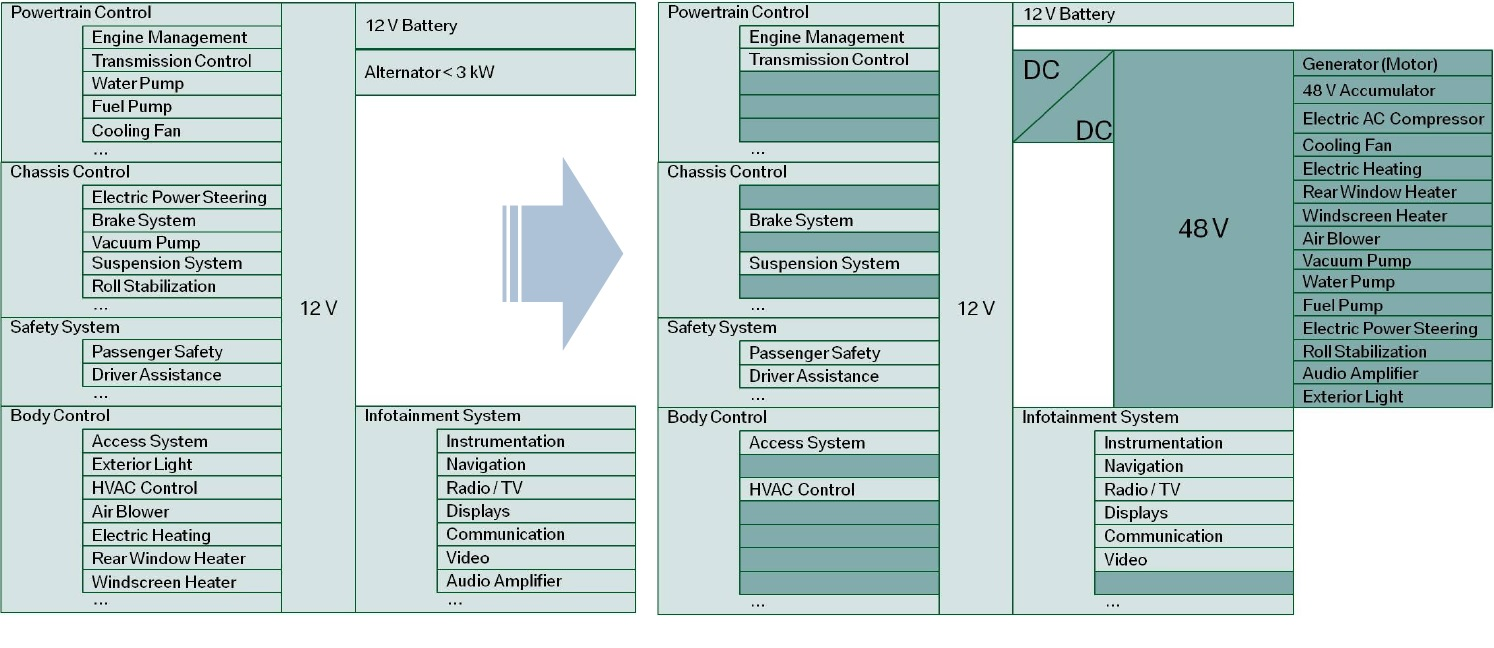Challenges for next-gen automotive power systems
What do you get when you cross tougher emissions and fuel economy standards, 48V lithium-ion battery technology, energy harvesting and high-power applications such as Electric Power Steering (EPS), Brake-By-Wire (BBW) and Heating, Ventilation & Air-conditioning (HVAC) systems? By Philip Chesley, Vice President, Precision Products, Intersil.
You get the perfect environment for a fundamental change in automotive battery systems, one that will create a tremendous tailwind for semiconductor suppliers over the next decade.
There’s nothing new about the story of the electrification of cars. In fact, in the '90s, innovative thinkers were working on a 42V standard to dramatically increase the voltage of existing 12V systems and enable the introduction of electric motors for a variety of subsystems; from steering to lighting. But other innovations enabled these applications to run off of 12V supplies and the idea of larger battery packs to support the higher voltage never took hold.
A number of catalysts have moved hybridisation of vehicles beyond a concept and into reality and are creating a whole new area of innovation for semiconductor suppliers. The new standard, adopted by most car makers for models coming as early as 2015, is referred to as 48V BoardNet. This time, the change is for real and the evolution of battery technology has been a key factor. While a conventional lead-acid battery is still used in the system to support a 12V network for ‘light’ loads, a 48V lithium-ion battery operates a separate 48V network that supports key functional systems, including power steering, high-end audio systems and HVAC systems. Lithium-ion batteries have significantly higher energy density and simply weigh less, in addition to having more charge.
The ability to support high voltage within the vehicle opens up a number of very interesting opportunities to improve the efficiency of the car. Driving at low speeds and in stop and go traffic no longer eats up gasoline, but instead can be a source of harvested energy that can be stored in the electrical system and reused to ultimately reduce fuel consumption. The need to have the automobile ‘always-on’ so it can communicate with a smartphone to remotely start the cooling or heating system and engage or disengage alarm and infotainment systems, for example, can more readily be supported with accurate battery management that increases efficiency and adds battery life.
The convergence of the right technology, the regulatory environment mandating lower fuel emissions and the opportunity for meaningful energy savings is expected to translate to a strong increase in demand for vehicles supporting higher voltage standards. According to a forecast by Lux Research, the 48V micro-hybrid market will become a $788m opportunity by 2024, with the first adoption year beginning in 2015. Early adoption is focused on premium vehicles, with global demand led by Europe, the US and China.
Opportunities
For semiconductor suppliers, the move to 48V is significant as it requires a much different level of capability to provide reliable solutions that are also cost effective. There are very few suppliers today with the ability to provide auto-grade solutions up to 72V, offering the headroom required to support the 48V standard. Standard high voltage processes don’t readily support mixed-signal devices like precision converters and amplifiers. Suppliers are instead developing proprietary process technologies that can deliver the precision required, in a high voltage process, cost effectively.
The stringent technical requirements create an opportunity for suppliers with the know-how and the familiarity with the rigours of the automotive market to deliver. For example, a few key focus areas where this innovation directly impacts the driving experience are management for start-stop applications, safety and efficiency.
In hybrid vehicle start-stop applications, there are many systems including the alarm, infotainment, rear view cameras and others that can be switched off unintentionally if there is a glitch with the stop-start. It is critical that buck-boost devices can maintain the output power, even when the input drops to as low as 1.8V, allowing these systems to continue to function.

Figure 1 - Many systems will migrate to the 48V sub-system
Safety is the other key concern. A hybrid/electric vehicle may have from 96 to 190 cells. To accurately monitor the voltage, current and temperature across the cells and communicate that information reliably is critical to maintaining the safe operation of the vehicle. This communication has to be cost effective, reducing wire count and increasing robustness. Intersil developed an innovative daisy chain communications protocol that can operate over long cable lengths. This replaces the traditional method of attaching a battery module, a balancing IC, an MCU and a CAN interface to a central control unit, which is costly and introduces many points of potential failure.
Accuracy of course is required for any IC technology applied to this market. Intersil, for example, has applied innovative power solutions to deliver up to a 10% improvement in efficiency by monitoring each battery cell to 3mV accuracy. In a practical application, this means the driver increases a vehicle’s range from 100 to 110 miles. Or, you can think of the longevity of the battery pack, which is typically warrantied up to 10 years. That 10% efficiency gain adds an additional one year to the battery life.
And finally flexibility is very important. The evolving power requirements and new standards create complexity for automotive OEMs and their partners designing the power systems. The ability to create one design and reuse it across power system loads and support 12, 24 and 48V requirements results in significant time and cost savings. Intersil developed a highly integrated and versatile buck converter specifically designed to enable easy conversion from high primary rails (Vin – typically 12, 24 or 48V) to lower secondary rails (Vout – typically 3.3, 5 or 12V). An integrated peak current mode synchronous PWM controller and integrated high-side and low-side FET drivers further improve efficiency. With more innovations to come, the automotive market will be the proving ground for many of the most important power breakthroughs in semiconductors over the coming decade.











